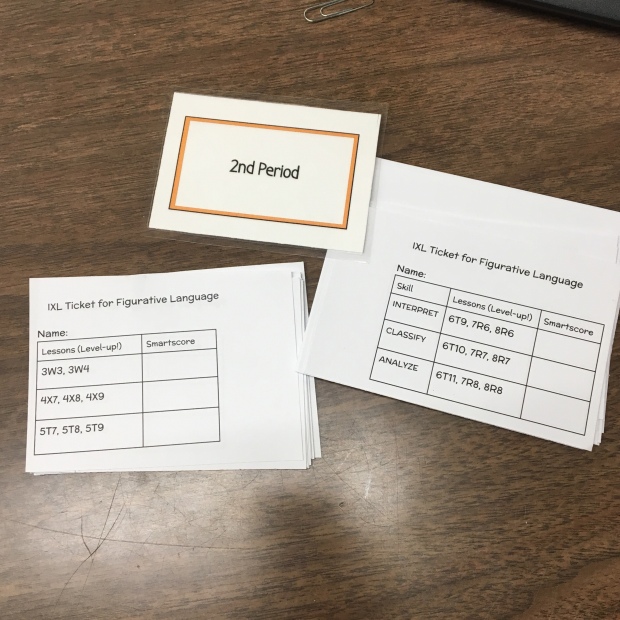Managing the Differentiation of IXL Assignments in My Classroom
I’ve tried several ways to assign IXL so that the assignments are appropriate and differentiated.
(If I were using IXL for math, I could have students use the Recommended Lessons on the Math Diagnostic, but that isn’t an option for Language Arts.)
I’ve found a good way to assign a series of lessons on a given topic that will meet the needs of my students who range from Beginning Reader to Lexiles in the 1100s.
These tiny IXL tickets get stapled into the student’s agenda books so they have the sequence of lessons with them at all times. Students mark off each lesson they complete, and then I meet with them near the due date (typically two weeks) to check their progress and award stickers for their iPhones.

Below are the PDF versions of the IXL Tickets I’ve used in class most recently. I plan on going back and tweaking some from earlier in the year.
When you take a look at these files, you will see they cover different grade levels and sequences depending on the skills.
Students have the option of working horizontally or vertically on some tickets, finding just the right place for them. As always, I encourage them to “Level Up!” when they can.
IXL Ticket Author’s Tone and Purpose
IXL Ticket Figurative Language
IXL Ticket Compare and Contrast Text 6-8
“The Monsters Are Due on Maple Street” – Vocabulary Unit
My 7th graders just read the Rod Serling teleplay, “The Monsters are Due on Maple Street.” I was able to find an adapted version that went with our Holt literature series and with some doubling up on parts, my class of 8 students was able to read the play out loud.
Being the first play we’ve done all year, this group was a little hesitant, unlike in the past when I’ve done reader’s theater type activities with our novels.
By Act II, some of them really started to get into their roles, and we had a great time. After reading the play, we watched The Twilight Zone version and did some comparing and contrasting.
This is the frame I used for the compare and contrast lesson after viewing the video. (I stopped the video at several exciting points to allow them time to record their thoughts in their journals and to build suspense.) Monsters Compare and Contrast Frame
Besides the obvious media vs. text lesson, one of my primary focuses for this reading selection was vocabulary. Between the stage directions and the narrator’s part, there were a lot of unknown words that allowed for context clue lessons.
I have attached the Vocabulary Squares and the differentiated activities I created for my class. For the worksheets and the quiz, all of my sentences came from http://www.wordsinasentence.com as I explained here. I have also included a link to my Quizlet for the vocabulary words I have chosen.
Monsters HW Vocab Sentences
Monsters Vocabulary Tic Tac Toe
Monsters Vocab Squares
Monsters VOCAB QUIZ
Quizlet for Vocab practice
Standards: CC.7.RL.3, CC.7.RL.7, CC.7.L.4
Differentiated Literature Circles
My 7th graders are starting A Wrinkle in Time in about two weeks and I decided to use Literature Circles. This will be my second time attempting Lit Circles and this time, with a push from our district, I created two versions of each role to meet the needs of various learners in my classroom. Read this previous post about my first experience with Lit Circles.
The “A” version is for my higher resource students and my “B” version will be for some of my students who are alternatively assessed and follow the extended standards. Here is an example for one of the roles.
A few students will be paired up so that they are doing the same task as a classmate but at a different level. For example, I will have two students doing the “Discussion Director” tasks for the same chapter but one will do the A version and one will do the B version. Everyone will be responsible for participating daily. (See the grading system at the end of the unit).
The roles are similar to those I used last year, but with new worksheets and a page with the corresponding standards.
- Word Wizard
- Passage Picker
- Clever Connector
- Figurative Language Lover
- Discussion Director
- Sci-Fi Guy (aka Game Changer)
As we read the book, I’ll try to update on our progress and success. Let me know what you think and if you see any immediate changes that need made.
Differentiated Vocabulary Boosting Activities
There are a lot of theories about teaching vocabulary. Are you bored with your method? Is it not working as well as you’d like it to? Are you looking for something other than flash cards or your standard vocabulary activities?
Try some of these activities I created for our 7th grade Inclusion Language Arts class. These activities allow for differentiation, discussion, and real world experiences with vocabulary words taught in class.
We are currently using these activities with vocabulary from A Wrinkle in Time. The students were broken into appropriate groups (test scores and our best judgement), and each group received 2 or 3 of these activities to complete.
The activities require students to make connections, use vocabulary in short narrative paragraphs, break words into syllables, identify word parts and parts of speech, use metacognitive strategies, and discuss and use vocabulary with peers in real conversation.
I am attaching the PDF (Differentiated Vocabulary Activities PDF) and I will also attach a link to a Word file you can save and edit for your own purposes. (Word version)
What are some of your favorite ways to teach vocabulary?
How do you differentiate your vocabulary assessments?
I’d love to hear your ideas!
ReadNRespond App
The ReadNRespond App is one I found a few months ago. This app covers Bloom’s Taxonomy in an interactive way. Each of the 6 levels shown below (in my handmade bulletin board display) has 20 different prompts/questions.
For a few different selections we read, I assigned numbers as you can see in the photo. Students worked in groups and worked their way down the list from Recall to Create. For some of my students I just focused on the lower level prompts.
Pros:
- There are lots of unique prompts at various levels
- It’s easy to differentiate and challenge students
- Students think it’s fun and enjoy the activities.
Cons:
- It is very hard for them to go back and edit their work so I can’t offer much in corrective feedback.
- Some students dislike typing on the iPad.
- Checking their work is a little tricky to since we aren’t one-to-one.
I tried having them screen shot their answers so I could flip through the photos to check their work. Didn’t really work
The best way I can use this app is put the assignment up on the bulletin board, have them access the activities, and complete them on paper to turn in.
If nothing else, just check out the 120 leveled prompts. You might find something you can modify to suit your needs.
School Talk on a Saturday Night
As I have mentioned before, my boyfriend is a 5th grade language arts/social studies teacher. We live about 25 minutes apart and if we are lucky, we see each other twice a week.
We’ve been very busy the last few weeks with four kids (three in fall sports), back-to-school business, our anniversary, a Jason Mraz concert, and my 20th High School Class Reunion.
Last night was supposed to be another event…the Cleveland Indians game and a trip to the new casino with my brother and some other friends. By yesterday morning, everyone had backed out and we had a night with no kids and no plans.
We decided to skip the game. Instead, I brought two dinners from a chicken BBQ near my house and we went out to Target and Kohl’s and then stopped at Yogurt Vi.
We then came home and on a Saturday night…sat at the kitchen table and did school work while we listened to music and had some refreshments. The irony of this? We said earlier in the day that we’d talk about school for 10 minutes max. We are such nerds.
We each did our own work, shared some ideas, and just talked.
I showed him WorksheetWorks.
I try not to use too many worksheets. However, this site generates worksheets on all subjects for free. The worksheets are customizable in terms of types of question and layout. They are neat and clean and just what I was looking for.
Each time you hit “Create Worksheet” you get different questions. They must have a very large question bank because I did not see repeats. I enlarged the worksheets to 150% and used the capture tool to put 4-5 questions on a SMARTBoard page. I quickly built a SMART file for the whole week.
I am going to use these pages with the dry erase boards some days. Other days I will just call students to the board. The hard copies will be used for assessments.
He showed me The New Differentiator.
This tool is an awesome way to get you thinking about how to differentiate your lessons to meet the needs of students. You easily create objectives by choosing from a menu for five categories: Thinking Skill, Content, Resources, Products, and Groups.
While I was checking this out, I explored a little more on Byrdseed. This blog looks like a great resource for TAG students or higher-level learners.
The other thing we discussed for awhile was the whole “teaching to the test.” We were talking about putting the Common Core Standards in our lesson plans and he made a comment about how he likes having the standards as a guide because he likes teaching to the test and he likes knowing exactly what he needs to cover.
“Teaching to the test??” I stopped him right there. I asked him to explain what he meant again and I had this weird Aha! moment.
I have heard teachers say, “We have to teach to the test.”
“We are limited on what we can do because we have to teach to the test.”
“The test stifles my creativity.”
“There’s so many things we can’t cover because we have to teach to the test.”
At the risk of offending anyone, I think these statements could be excuses or cop-outs….a way to just plow through material with minimal prep work. Is it these teachers who are bored and frustrated with their job?
What if teachers viewed the standards like he does? As a guide and not as limits?
Yes, he has to cover certain things. He still words his assessments with test-like lingo. He assigns 2-pt. and 4-pt. questions for daily journal writing.
How he chooses to teach the standards on a daily basis is completely up to him. His creativity is not stifled.
He is one of the most creative people I know.











